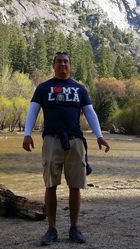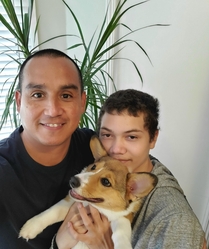Going out to buy groceries, going out for a walk, driving your kid back home from school. For most people these activities are normal, everyday things with little to no excitement, as they should be. Unfortunately, getting food, exercising, and supporting my son’s education have been a little more out of the ordinary for me.

You see, I am a Mexican Indigenous man, brown skin, shaved head. My ethnicity and physical appearance are by no means unusual, especially in the part of the country where I live. However, these characteristics, which are a vital piece of who I am, are cause enough for continual harassment by the police. In some cases it has led to unlawful detention and in others a simple warning was delivered. But in all cases, it has led to anxiety, stress, and trauma -- indeed, I am shaking and sweating while writing this. Below, I will share a recent experience I had with the police.
A couple of weeks ago, I woke up and decided to go get groceries for my son and me before beginning an exciting day at work. I got to the grocery store, located in the Bayview neighborhood of San Francisco. The Bayview is a predominantly Black and underserved neighborhood in the southeast section of the city, which has its own issues with crime and over-policing. After making my purchases, I headed home. Suddenly I look in my rearview mirror and see the blue and red lights of a black SUV flashing behind me. So I pull to the side of the street, like we are obliged to for emergency vehicles. Not for a moment did I think I was being pulled over.
But as I pull to the curb, I do not see the police fly by me. Rather, I see them pull over behind me.
At this moment, I freeze and am struck with anxiety and fear. Immediately, my mind starts thinking about how to survive this encounter, how to make sure that my son was going to be OK if something happens to me, what I am going to tell my coworkers, whether I’m going to jail, and, ultimately, whether I will live through this. Seeing the police officers walking in my direction forced me to collect my thoughts and emotions, to handle this as best I can. This wasn’t the first time.
When the officers reached my windows, the one nearest to me requested that I get out of my car. He said I matched the description of someone they had been looking for. That is the only explanation I ever received.
As I got out of the car, the officers told me I was being handcuffed for their protection. After being handcuffed, I was told to sit on the curb and to shut up. I was then asked, “Where do you keep the gun and drugs?” As I told them that I don’t do drugs and had never held a gun, I was asked for permission to search the car. To which I replied, “No.” After which I was informed that they would be requesting a K-9 unit to search the perimeter of the car with the dog. Which prompted me to change my mind and give permission for the search. At this point, I just wanted to go home, but that was not going to happen. So I sat on the curb waiting for the other police unit to arrive, sweating, shaking, afraid.
When the K-9 unit arrived, they conducted the search, which was inconclusive. I was told that my car needed to be towed to be more thoroughly searched. I was then released and told to go to headquarters for my car. Which I did. I also filed a complaint. Then I went home and broke down. This wasn’t the first time.
To some, this would be an egregious inconvenience, to others an affront to their freedom, but not to me. To me, this experience was a trigger. As I sat with my anxiety and facade of toughness, my mind was in survival mode: “How am I going to survive this? I have absolutely no control over this situation.” This was not the first time.
You see, I am an individual who experienced 9 of the 10 original ACEs growing up and into adulthood. Although the CDC-Kaiser Permanente Adverse Childhood Experiences Study (ACE Study) still isn’t widely known, even though it’s been around for 20 years, it and the other parts of ACEs science are providing a profound shift in our understanding about why we humans behave the way we do.
The ACE Study found that the higher someone’s ACE score—the more types of childhood adversity a person experienced—the higher their risk of adverse social, economic, health and civic consequences. The study found that most people (64%) have at least one ACE; 12% of the population has an ACE score of 4 or higher. Having an ACE score of 4 nearly doubles the risk of heart disease and cancer. It increases the likelihood of becoming an alcoholic by 700 percent and the risk of attempted suicide by 1200 percent. It increases obesity, violence, and mental illness. Forty-three U.S. states, many countries and countless organizations have done their own ACE surveys, and the results are remarkably similar. (To calculate your ACE and resilience scores, go to: Got Your ACE/Resilience Score?)
A person with a high ACE score from childhood, and who is continually retraumatized as an adult by traumatic experiences such as being pulled over by police for no reason, handcuffed for no reason, and having his car searched for no reason, is likely to have high levels of stress and to be easily triggered by an event such as this. So this experience didn’t end with me getting my car back and going home. It persisted. This wasn’t the first time.
What this experience triggered was days of anxiety and trauma recovery. By trauma recovery, I mean that I was experiencing elevated levels of stress. It made me feel like the times my dad would assault me, emotionally, physically, sexually, and verbally. I had no control over those situations, just like I had no control over this one. Which then led me to have other feelings. It made me feel that I was less than human. It made me feel like I have no place in this world. It made me think the unthinkable, self-harm. These feelings have led to a state that I have not fully recovered from, but will. This wasn’t the first time.
This is an experience that people of color face every day. An experience that has taken the lives of people of color. This is an experience that has broken families, lives, and communities. We know this wasn’t the first time. In fact, for people of color, this experience has been going on for centuries, in some form or another. People of color have experienced dehumanization, enslavement, family separation, and countless other forms of trauma. And this is an experience that is dividing our country right now.
Today people of color face adversity, stress, and trauma from different sources. In this example, I highlight just one incident that I experienced from one source, the San Francisco Police Department. Fortunately, this incident ended with no violence and no further trauma. Unfortunately, many of these experiences do not end this way. In countless incidents with the police, people of color come away arrested, beaten, traumatized, and violated. They come away broken, if at all.
My experience with the SFPD that day caused me to suffer through anxiety, fear, stress, and trauma. It wasn’t the first time something like this has happened to me or other people of color.
And to the detriment of all of us, this is no doubt not the last time, either.

Rafael Maravilla was raised in Planada, CA, but grew up in East Oakland, CA. He attended UC Berkeley where he studied neurobiology. He also attended UC Merced where he studied sociology. Rafael was also trained at the Harvard Kennedy School of Government. He is working on his MS at UCSF with an interest in the intersection of adverse childhood experiences and big data. Rafael currently lives in San Francisco with his son, Adam and their Corgi, Kiba.



Comments (0)